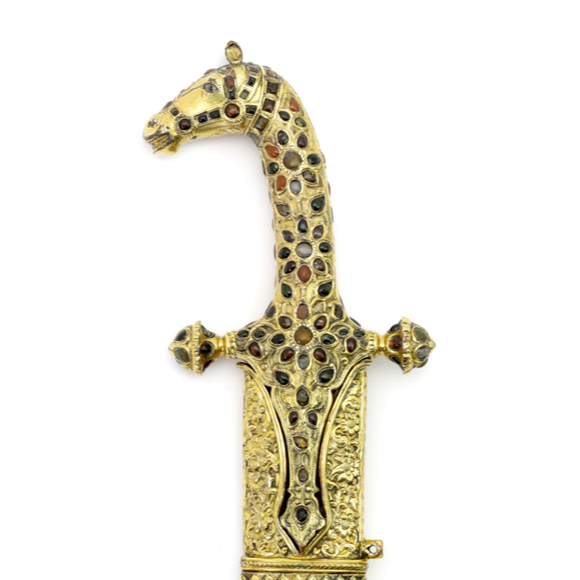With a fine wootz blade with a pronounced center ridge.

219.7 cm
Blade length 20.8 cm
Caliber 14 mm
1265 grams
Iron, steel, bamboo, brass
North India
Circa 1800
Ex Robin Wigington collection
A European private collector
Description
An extremely rare Indian lance, showing a merge of European technology and Indian ingenuity.
It combines a substantial blade of unusual cross-section with a short smooth barrel and British-style flintlock mechanism. The hammer is triggered by pressure on the spring-loaded spearhead. Just point and stab, easy.


The blade's cross-section is hollow on the barrel side to create clearance for the musket ball and has a center ridge at the bottom. The tip is reinforced, of bodkin shape.

The gun's muzzle is shaped like a makara, a beast from Hindu mythology. The whole is very detailed and well-crafted. Discoloration on the base of the gun seems indicative of heat produced when used.

The head is mounted on a long bamboo shaft by means of screwing to an iron mount at the front of the shaft. There is another such mount at the other end of the shaft, with larger thread. Probably this end used to hold some sort of spike or counterweight, now lost.
There are some old, partial labels on the shaft with local script on it.
Condition
In good, original condition throughout. The front thread was worn, I had it invisibly restored. Some age-related splits to the bamboo shaft, but of no structural consequence.
Dating & attribution
The flintlock mechanism with "swan neck" hammer appears to be inspired by British models, as seen for example on the "Brown Bess" British Land Pattern Musket that was in service from 1722–1851. British locks were particularly popular among the Talpurs of Sindh, who took them off high-end English guns and mounted them on their own.1
Swan neck hammers are also found on combination katar, like one in the Royal Collection Trust, accession number RCIN 11344 and a flintlock walking stick in that same collection, accession number RCIN 37960. Both were presented to Prince Edward by Ram Singh, Maharao of Bundi during the Indian tour of 1875-76. The locks on these weapons are released with triggers, not blade pressure like this lance.
The makara muzzle end is the only stylistic feature that may give a hint of origins. It is sometimes seen on matchlocks from north India and guns from Sindh.2 It also featured on a fine Indian toradar with inlaid stock I sold previously. Comparison to other examples with similar stock helped attribute this to the Punjab area.

Makara muzzled toradar. Punjab, circa 1800.
Sold by Mandarin Mansion in 2018.
It is hard to make a very firm attribution but I suspect the piece dates from circa 1800, and is from the general area of Rajasthan and the Punjab.
Notes
1. Captain Postans, 1843: "Some very good imitations of the European flint lock are to be met with; our guns and rifles, indeed, are only prized for this portion of their work; the barrels are considered too slight, and incapable of sustaining the heavy charge which the Sindhian always gives his piece. The European lock is attached to the Eastern barrel; the best of Joe Manton's and Purdy's guns and rifles, of which sufficient to stock a shop have at various times been presented to the Sindhian chiefs by the British government, share this mutilating fate." From Captain Postan; Personal observations on Sindh. Page 103.
2. For two Sindh guns with this feature, see Robert Elgood; The Maharajah of Jodhpur's Guns. Niyogi Books, Delhi, 2020. Pages 164-165.
Provenance
The piece came from the collection of Robin Wigington, a British dealer of arms and armor who amassed a large collection of items related to the Tipu Sultan. A noted expert in this field, he wrote the book Firearms of Tipu Sultan, 1783-99, published by John Taylor Book Ventures in 1992.



















The style typical of Kutch, the execution far above what is normally seen on work from that area.
Nice and complete with opaque green hilt and scabbard mounts.
With designs of animals, often attributed to Lucknow, north India.






